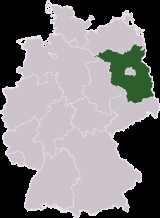
High Fläming Nature Park
Encyclopedia
High Fläming Nature Park is a 827 km² nature park in Potsdam-Mittelmark
district in the German state Brandenburg
. It is the third largest of 11 nature parks in the state of Brandenburg. In 1997, it was declared a nature park by the State Minister for the Environment.
There is a visitor center in Rabenstein/Fläming offering information, an interesting exhibition, a bike rental and a shop with regional products.
and Potsdam
and covers the higher parts of the Fläming
hill chain. Its location is indicated by a red dot on the Brandenburg map on this page. The highest elevation is the Hagelberg (200,24 m). It borders in the southwest on the Fläming Nature Park
in the state of Saxony-Anhalt
.
About 27.000 people are living in the area. Belzig
is the central town in the park. Other towns in the Park include Wiesenburg/Mark
, Görzke
, Niemegk
and Brück
. The population density is 30 inhabitants per km².
About half of the area is forests, the other half is agricultural land. There are few lakes, but some clear creeks and small rivers that provide a habitat for several protected species.
The Nature Park has very good traffic infrastructure: By car it can be reached using highway A 2 (Berlin-Hannover) (interchanges Ziesar (76), Wollin (77), Brandenburg (78)) or highway A 9 (Berlin - Leipzig) (interchanges Brück, Niemegk und Klein Marzehns). There is also a good railroad connection from Berlin, Potsdam and Dessau
.
The nature park area is about half wooded, and the other half is agricultural land. It is characterized by a constant change of forest and field. In some places, you will see the original beech forest. Open lakes and other water - apart from a few ponds - there are hardly any. However, there are many brooks that are among the cleanest in Brandenburg and are very valuable for nature protection.
With the so-called "Rummeln", a form of dry valleys, the High Fläming has a unique botanical and geological feature.
, Red Deer
, Raccoon Dog
and the Mouflon
). Among the most noteworthy species in the Nature Park are the Black Stork
, the Common Noctule
, a Microbat
, and the Middle Spotted Woodpecker
, the mascot of the nature parks. In the creeks the Brown Trout
, the White-throated Dipper
, the Brook lamprey
and the European crayfish
can be found. The Great Bustard
and the Western marsh orchid
are native to the lowlands.
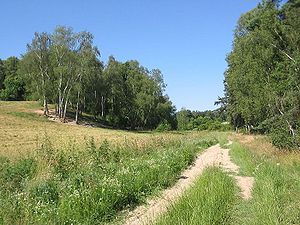 Virtually the entire natural park area is a landscape protection area. The regulation on the landscape conservation area "Hoher Fläming und Belziger Landschaftswiesen" of 17 November 1997 became effective on 3 December 1997.
Virtually the entire natural park area is a landscape protection area. The regulation on the landscape conservation area "Hoher Fläming und Belziger Landschaftswiesen" of 17 November 1997 became effective on 3 December 1997.
Moreover, there are nine nature reserves in the nature park . Some of the valuable streams
in the Fläming are protected (Verlorenwasserbach, Bullenberger Bach, Planetal). There is also protected forest and moorland (Rabenstein, Spring, Werbiger Heide). Some nature reserves have been set up by the GDR. The nature protection areas (with the date of entry into force) in the nature park are those:
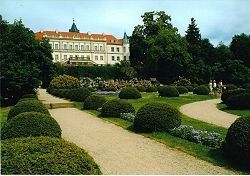
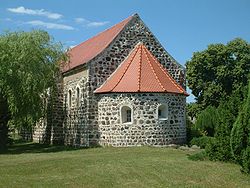

Presently there is a museum and a hotel in Eisenhardt Castle in Belzig.
Wiesenburg Palace is privately owned and is used for residential purposes. The castle tower can be visited and houses the tourist information of the community. The Palace has a park that is designed as a landscape park. The 123-hectare park is considered the most important park between Potsdam and the Dessau-Wörlitz Gardens. In 2004, there was a sculpture exhibit in the park.
Ziesar Castle houses a museum on the history of Christianity the Mark Brandenburg.
There is a hostel and a restaurant in Rabenstein Castle.
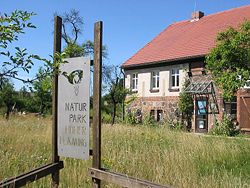 The visitor center of the Nature Park is located in the village Raben in the municipality Rabenstein/Fläming. The building now used as visitor center is called "Old Distillery" because in the 18th century it was a liquor distillery. It was constructed around 1700 as a commercial building for Rabenstein Castle. From 1863 it was used as a pumping station to secure the water supply of the castle. Remnants of the horse-driven gear and water boilers can still be seen today. After a period of decline from 1945, in 1996 the historic building was finally restored by Potsdam-Mittelmark County in order to become the visitor center of the new Nature Park. In May 1997, the visitor center was opened to the public. The visitor information is run by the Nature Park Association Fläming.
The visitor center of the Nature Park is located in the village Raben in the municipality Rabenstein/Fläming. The building now used as visitor center is called "Old Distillery" because in the 18th century it was a liquor distillery. It was constructed around 1700 as a commercial building for Rabenstein Castle. From 1863 it was used as a pumping station to secure the water supply of the castle. Remnants of the horse-driven gear and water boilers can still be seen today. After a period of decline from 1945, in 1996 the historic building was finally restored by Potsdam-Mittelmark County in order to become the visitor center of the new Nature Park. In May 1997, the visitor center was opened to the public. The visitor information is run by the Nature Park Association Fläming.
An exhibition on the upper floor of the visitor center informs about all aspects of the Nature Park. In addition, there is tourist information which offers maps and leaflets with route recommendations and literature. In the basement vaults of the Garden House there is a shop selling local products, like pottery, honey, beeswax candles, jams and jellies and fruit schnapps. There is also a bike rental. The visitor center is open daily from 9.00 to 17.00 pm.
In the visitor center, the Nature Park administration and the Nature Park Association Fläming have their offices.
Potsdam-Mittelmark
Potsdam-Mittelmark is a Kreis in the western part of Brandenburg, Germany. Neighboring are the district Havelland, the district free cities Brandenburg and Potsdam, the Bundesland Berlin, the district Teltow-Fläming, and the districts Wittenberg, Anhalt-Bitterfeld and Jerichower Land in...
district in the German state Brandenburg
Brandenburg
Brandenburg is one of the sixteen federal-states of Germany. It lies in the east of the country and is one of the new federal states that were re-created in 1990 upon the reunification of the former West Germany and East Germany. The capital is Potsdam...
. It is the third largest of 11 nature parks in the state of Brandenburg. In 1997, it was declared a nature park by the State Minister for the Environment.
There is a visitor center in Rabenstein/Fläming offering information, an interesting exhibition, a bike rental and a shop with regional products.
Geography
The park is located about 80 km southwest of BerlinBerlin
Berlin is the capital city of Germany and is one of the 16 states of Germany. With a population of 3.45 million people, Berlin is Germany's largest city. It is the second most populous city proper and the seventh most populous urban area in the European Union...
and Potsdam
Potsdam
Potsdam is the capital city of the German federal state of Brandenburg and part of the Berlin/Brandenburg Metropolitan Region. It is situated on the River Havel, southwest of Berlin city centre....
and covers the higher parts of the Fläming
Fläming
The Fläming Heath is a region and a hill chain that reaches over 100 km from the Elbe river to the Dahme River in the German states Saxony-Anhalt and Brandenburg. Its highest elevation is the Hagelberg...
hill chain. Its location is indicated by a red dot on the Brandenburg map on this page. The highest elevation is the Hagelberg (200,24 m). It borders in the southwest on the Fläming Nature Park
Fläming Nature Park
The Fläming Nature Park is a nature park with 824 km² in Saxony-Anhalt, Germany, opened in 2005. It is one of six nature parks in the state Saxony-Anhalt....
in the state of Saxony-Anhalt
Saxony-Anhalt
Saxony-Anhalt is a landlocked state of Germany. Its capital is Magdeburg and it is surrounded by the German states of Lower Saxony, Brandenburg, Saxony, and Thuringia.Saxony-Anhalt covers an area of...
.
About 27.000 people are living in the area. Belzig
Belzig
Bad Belzig, also known as Belzig, is a historic town in Brandenburg, Germany located about southwest of Berlin. It is the capital of the Potsdam-Mittelmark district.-Geography:...
is the central town in the park. Other towns in the Park include Wiesenburg/Mark
Wiesenburg (Mark)
Wiesenburg is a municipality in the Potsdam-Mittelmark district, in Brandenburg, Germany. It is situated 11 km west of Belzig, and 46 km southwest of Brandenburg...
, Görzke
Görzke
Görzke is a municipality in the Potsdam-Mittelmark district, in Brandenburg, Germany.-References:...
, Niemegk
Niemegk
Niemegk is a town in the Potsdam-Mittelmark district, in Brandenburg, Germany. It is situated 10 km southeast of Belzig, and 23 km north of Wittenberg. It is located in the High Fläming Nature Park....
and Brück
Brück
Brück is a town in the Potsdam-Mittelmark district, in Brandenburg, Germany. It is situated 29 km southwest of Potsdam, and 28 km southeast of Brandenburg. Parts of Brück are located in the High Fläming Nature Park....
. The population density is 30 inhabitants per km².
About half of the area is forests, the other half is agricultural land. There are few lakes, but some clear creeks and small rivers that provide a habitat for several protected species.
The Nature Park has very good traffic infrastructure: By car it can be reached using highway A 2 (Berlin-Hannover) (interchanges Ziesar (76), Wollin (77), Brandenburg (78)) or highway A 9 (Berlin - Leipzig) (interchanges Brück, Niemegk und Klein Marzehns). There is also a good railroad connection from Berlin, Potsdam and Dessau
Dessau
Dessau is a town in Germany on the junction of the rivers Mulde and Elbe, in the Bundesland of Saxony-Anhalt. Since 1 July 2007, it is part of the merged town Dessau-Roßlau. Population of Dessau proper: 77,973 .-Geography:...
.
Landscape
The nature park is divided into two sections: In the south, the hilly and wooded landscape of the High Fläming and in the north a flat lowland, called "Belziger Landschaftswiesen" (Belzig landscape meadows). The more than 140,000-year-old heights are moraines.The nature park area is about half wooded, and the other half is agricultural land. It is characterized by a constant change of forest and field. In some places, you will see the original beech forest. Open lakes and other water - apart from a few ponds - there are hardly any. However, there are many brooks that are among the cleanest in Brandenburg and are very valuable for nature protection.
With the so-called "Rummeln", a form of dry valleys, the High Fläming has a unique botanical and geological feature.
Animals and plants
The Fläming is rich in wildlife (Fallow DeerFallow Deer
The Fallow Deer is a ruminant mammal belonging to the family Cervidae. This common species is native to western Eurasia, but has been introduced widely elsewhere. It often includes the rarer Persian Fallow Deer as a subspecies , while others treat it as an entirely different species The Fallow...
, Red Deer
Red Deer
The red deer is one of the largest deer species. Depending on taxonomy, the red deer inhabits most of Europe, the Caucasus Mountains region, Asia Minor, parts of western Asia, and central Asia. It also inhabits the Atlas Mountains region between Morocco and Tunisia in northwestern Africa, being...
, Raccoon Dog
Raccoon Dog
The raccoon dog , also known as the magnut or tanuki, is a canid indigenous to east Asia. It is the only extant species in the genus Nyctereutes...
and the Mouflon
Mouflon
The mouflon is a subspecies group of the wild sheep Ovis aries. Populations of Ovis aries can be partitioned into the mouflons and urials or arkars...
). Among the most noteworthy species in the Nature Park are the Black Stork
Black Stork
The Black Stork Ciconia nigra is a large wading bird in the stork family Ciconiidae. It is a widespread, but rare, species that breeds in the warmer parts of Europe, predominantly in central and eastern regions. This is a shy and wary species, unlike the closely related White Stork. It is seen in...
, the Common Noctule
Common Noctule
The Common Noctule is a species of bat common throughout Europe, Asia, and North Africa. The UK distribution can be found on the National Biodiversity Network website ....
, a Microbat
Microbat
The microbats constitute the suborder Microchiroptera within the order Chiroptera . They are most often referred to by their scientific name...
, and the Middle Spotted Woodpecker
Middle Spotted Woodpecker
The Middle Spotted Woodpecker is a European woodpecker belonging to the genus Dendrocopos.The Middle Spotted Woodpecker is 20–22 cm long and has plumage similar to the Great Spotted Woodpecker. As with that species the upperparts are predominantly black with white oval wing patches and white...
, the mascot of the nature parks. In the creeks the Brown Trout
Brown trout
The brown trout and the sea trout are fish of the same species....
, the White-throated Dipper
White-throated Dipper
The White-throated Dipper , also known as the European Dipper or just Dipper is an aquatic passerine bird found in Europe, Middle East, Central Asia and the Indian Subcontinent. The species is divided into several subspecies, based primarily on colour differences, particularly of the pectoral band...
, the Brook lamprey
Brook lamprey
The European brook lamprey is a small European lamprey species that exclusively inhabits freshwater...
and the European crayfish
Astacus astacus
Astacus astacus, the European crayfish, noble crayfish or broad-fingered crayfish, is the most common species of crayfish in Europe, and a traditional foodstuff. Like other crayfish, Astacus astacus is restricted to fresh water, living only in unpolluted streams, rivers and lakes...
can be found. The Great Bustard
Great Bustard
The Great Bustard is in the bustard family, the only member of the genus Otis. It breeds in southern and central Europe, where it is the largest species of bird, and across temperate Asia...
and the Western marsh orchid
Western marsh orchid
The western marsh orchid is a terrestrial European orchid. Its flowering period begins at lower elevations as early as the beginning of May and ends in higher elevations at the end of July...
are native to the lowlands.
Protected areas

Moreover, there are nine nature reserves in the nature park . Some of the valuable streams
STREAMS
In computer networking, STREAMS is the native framework in Unix System V for implementing character devices.STREAMS was designed as a modular architecture for implementing full-duplex I/O between kernel or user space processes and device drivers. Its most frequent uses have been in developing...
in the Fläming are protected (Verlorenwasserbach, Bullenberger Bach, Planetal). There is also protected forest and moorland (Rabenstein, Spring, Werbiger Heide). Some nature reserves have been set up by the GDR. The nature protection areas (with the date of entry into force) in the nature park are those:
- Bullenberger Bach / Briesener Bach (24 May 2003)
- Klein Marzehns (1 May 1961)
- Flämingbuchen (30 March 1961)
- Planetal (19 October 1967)
- Rabenstein (20 June 1978)
- Spring (17 March 1986)
- Verlorenwasserbach, Oberlauf (26 May 2005)
- Werbiger Heide (19 November 1999)
- Belziger Landschaftswiesen (24 May 2003)
Culture



Castles and palaces
Of particular interest are the four medieval castles in Fläming: Eisenhardt Castle in Belzig, Rabenstein Castle, Ziesar Castle and Wiesenburg Palace. In its present form Wiesenburg Palace is a neo-Renaissance building, but it was originally built as a medieval castle of which some elements are still preserved.Presently there is a museum and a hotel in Eisenhardt Castle in Belzig.
Wiesenburg Palace is privately owned and is used for residential purposes. The castle tower can be visited and houses the tourist information of the community. The Palace has a park that is designed as a landscape park. The 123-hectare park is considered the most important park between Potsdam and the Dessau-Wörlitz Gardens. In 2004, there was a sculpture exhibit in the park.
Ziesar Castle houses a museum on the history of Christianity the Mark Brandenburg.
There is a hostel and a restaurant in Rabenstein Castle.
Historic town centres
The historic town centres of Belzig and Ziesar and are worth visiting. Both cities are members of the Association of Cities with Historic City Centres in Brandenburg". Niemegk also has a historic city centre with a Renaissance town hall.Stone Churches
Typical for the Fläming are medieval churches, made of stones that were gathered in the region.kunst land hoher fläming - land art
Under the brand "kunst land hoher fläming" artists and others involved organize artistic activities in the countryside. It started in 2004 with the Sculpture Park at Wiesenburg Castle Park. In 2006, an "art trail" was realized, a 2.5 km long track with works of art designed by local artists. In the summer of 2007, a 17-km-long art track that connects the train stations of Belzig and Wiesenburg was opened. Ten works of art can be seen along the trail. The ten artists whose works have been realized, had prevailed in a nationwide art competition.Theatre and Concerts
Theater performances are regularly given in the summer in Wiesenburg Castle Park and in the courtyard of Ziesar Castle. In Belzig, the birthplace of the composer Carl Gottlieb Reißiger, his works are occasionally performed.Visitor Center "Old Distillery"

An exhibition on the upper floor of the visitor center informs about all aspects of the Nature Park. In addition, there is tourist information which offers maps and leaflets with route recommendations and literature. In the basement vaults of the Garden House there is a shop selling local products, like pottery, honey, beeswax candles, jams and jellies and fruit schnapps. There is also a bike rental. The visitor center is open daily from 9.00 to 17.00 pm.
In the visitor center, the Nature Park administration and the Nature Park Association Fläming have their offices.
Statistical data
- Total area: 827 km ² (100%)
- Nature reserves: 48.8 km ² (5.9%)
- Protected Areas: 754 km ² (91.2%)
- Population: about 27,000
- Population density: about 30 pe / km ²
- Agricultural area: 403 km ² (49%)
- Forest: 404 km ² (49%)
- Water: 0.3 km ² (0.1%)

